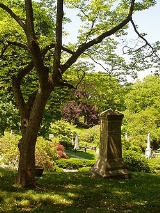
Mount Auburn Cemetery
Encyclopedia
Mount Auburn Cemetery was founded in 1831 as "America's first garden cemetery", or the first "rural cemetery
", with classical monuments set in a rolling landscaped terrain. The appearance of this type of landscape coincides with the rising popularity of the term "cemetery," which etymologically traces its roots back to the Greek for "a sleeping place." This language and outlook eclipsed the previous harsh view of death and the afterlife, pictorialized in old graveyards and church burial plots. The 174 acres (70.4 ha) cemetery is important both for its historical aspects and for its role as an arboretum
. Most of the cemetery is located in Watertown, Massachusetts
, though the 1843 granite Egyptian revival entrance lies in neighboring Cambridge
, adjacent to the Cambridge City and Sand Banks Cemeteries.
 The land that would eventually become Mount Auburn Cemetery was originally named Stone's Farm, though locals referred to it as "Sweet Auburn" after the 1770 poem "The Deserted Village" by Oliver Goldsmith
The land that would eventually become Mount Auburn Cemetery was originally named Stone's Farm, though locals referred to it as "Sweet Auburn" after the 1770 poem "The Deserted Village" by Oliver Goldsmith
. Mount Auburn Cemetery was inspired by Père Lachaise cemetery in Paris
and was itself an inspiration to cemetery designers, most notably at Abney Park
in London
. Mount Auburn Cemetery was designed largely by Henry Alexander Scammell Dearborn
with assistance from Dr. Jacob Bigelow
and Alexander Wadsworth.
Bigelow came up with the idea for Mount Auburn as early as 1825, though a site was not acquired until five years later. Bigelow, a medical doctor, was concerned about the unhealthiness of burials under churches as well as the possibility of running out of space. With help from the Massachusetts Horticultural Society
, Mount Auburn Cemetery was founded on 70 acres (283,280.2 m²) of land authorized by the Massachusetts Legislature for use as a garden or rural cemetery. The purchase of the original land cost $6,000; it later extended to 170 acre (0.6879662 km²). The main gate was built in the Egyptian Revival
style and cost $10,000. The first president of the Mount Auburn Association, Joseph Story
, dedicated the cemetery in 1831.
The cemetery is credited as the beginning of the American public parks and gardens movement. It set the style for other suburban American cemeteries such as Laurel Hill Cemetery
(Philadelphia, 1836), Mt. Hope Cemetery
, America's first municipal rural cemetery (Rochester, New York
, 1838), Green-Wood Cemetery
(Brooklyn
, 1838), The Green Mount Cemetery, Baltimore, Maryland 1838, Albany Rural Cemetery
(Menands, New York
, 1844) and Forest Hills Cemetery
(Jamaica Plain, 1848) as well as Oakwood Cemetery in Syracuse, New York
. It can be considered the link between Capability Brown
's English landscape garden
s and Frederick Law Olmsted
's Central Park
in New York (1850s).
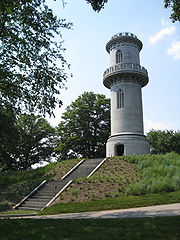 Mount Auburn was established at a time when Americans had a sentimental interest in rural cemeteries. It is still well known for its tranquil atmosphere and accepting attitude toward death. Many of the more traditional monuments feature poppy
Mount Auburn was established at a time when Americans had a sentimental interest in rural cemeteries. It is still well known for its tranquil atmosphere and accepting attitude toward death. Many of the more traditional monuments feature poppy
flowers, symbols of blissful sleep. In the late 1830s, its first unofficial guide, Picturesque Pocket Companion and Visitor's Guide Through Mt. Auburn, was published and featured descriptions of some of the more interesting monuments as well as a collection of prose and poetry about death by writers including Nathaniel Hawthorne
and Willis Gaylord Clark
. Because of the number of visitors, the cemetery's developers carefully regulated the grounds: They had a policy to remove "offensive and improper" monuments and only "proprietors" (i.e., plot owners) could have vehicles on the grounds and were allowed within the gates on Sundays and holidays.
 More than 93,000 people are buried in the cemetery as of 2003. A number of historically significant people have been interred there since its inception, particularly members of the Boston Brahmin
More than 93,000 people are buried in the cemetery as of 2003. A number of historically significant people have been interred there since its inception, particularly members of the Boston Brahmin
s and the Boston elite associated with Harvard University
as well as a number of prominent Unitarians
.
The cemetery is nondenominational and continues to make space available for new plots. The area is well known for its beautiful environs and is a favorite location for Cambridge bird-watchers. Guided tours of the cemetery's historic, artistic, and horticultural points of interest are available.
Mount Auburn's collection of over 5,500 trees includes nearly 700 species and varieties. Thousands of very well-kept shrubs and herbaceous plants weave through the cemetery's hills, ponds, woodlands, and clearings. The cemetery contains more than 10 miles (17 km) of roads and many paths. Landscaping styles range from Victorian-era plantings to contemporary gardens, from natural woodlands to formal ornamental gardens, and from sweeping vistas through majestic trees to small enclosed spaces. Many trees, shrubs, and herbaceous plants are tagged with botanic labels containing their scientific and common names.
The cemetery was among those profiled in the 2005 PBS documentary A Cemetery Special
.
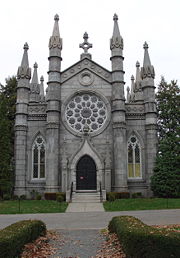
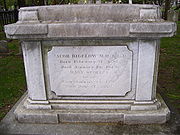
Rural cemetery
The rural cemetery or garden cemetery is a style of burial ground that uses landscaping in a park-like setting.As early as 1711 the architect Sir Christopher Wren had advocated the creation of burial grounds on the outskirts of town, "inclosed with a strong Brick Wall, and having a walk round, and...
", with classical monuments set in a rolling landscaped terrain. The appearance of this type of landscape coincides with the rising popularity of the term "cemetery," which etymologically traces its roots back to the Greek for "a sleeping place." This language and outlook eclipsed the previous harsh view of death and the afterlife, pictorialized in old graveyards and church burial plots. The 174 acres (70.4 ha) cemetery is important both for its historical aspects and for its role as an arboretum
Arboretum
An arboretum in a narrow sense is a collection of trees only. Related collections include a fruticetum , and a viticetum, a collection of vines. More commonly, today, an arboretum is a botanical garden containing living collections of woody plants intended at least partly for scientific study...
. Most of the cemetery is located in Watertown, Massachusetts
Watertown, Massachusetts
The Town of Watertown is a city in Middlesex County, Massachusetts, United States. The population was 31,915 at the 2010 census.- History :Archeological evidence suggests that Watertown was inhabited for thousands of years before the arrival of settlers from England...
, though the 1843 granite Egyptian revival entrance lies in neighboring Cambridge
Cambridge, Massachusetts
Cambridge is a city in Middlesex County, Massachusetts, United States, in the Greater Boston area. It was named in honor of the University of Cambridge in England, an important center of the Puritan theology embraced by the town's founders. Cambridge is home to two of the world's most prominent...
, adjacent to the Cambridge City and Sand Banks Cemeteries.
History

Oliver Goldsmith
Oliver Goldsmith was an Irish writer, poet and physician known for his novel The Vicar of Wakefield , his pastoral poem The Deserted Village , and his plays The Good-Natur'd Man and She Stoops to Conquer...
. Mount Auburn Cemetery was inspired by Père Lachaise cemetery in Paris
Paris
Paris is the capital and largest city in France, situated on the river Seine, in northern France, at the heart of the Île-de-France region...
and was itself an inspiration to cemetery designers, most notably at Abney Park
Abney Park Cemetery
Abney Park in Stoke Newington, in the London Borough of Hackney, is a historic parkland originally laid out in the early 18th century by Lady Mary Abney and Dr. Isaac Watts, and the neighbouring Hartopp family. In 1840 it became a non-denominational garden cemetery, semi-public park arboretum, and...
in London
London
London is the capital city of :England and the :United Kingdom, the largest metropolitan area in the United Kingdom, and the largest urban zone in the European Union by most measures. Located on the River Thames, London has been a major settlement for two millennia, its history going back to its...
. Mount Auburn Cemetery was designed largely by Henry Alexander Scammell Dearborn
Henry Alexander Scammell Dearborn
Henry Alexander Scammell Dearborn was an American lawyer, author, statesman and soldier...
with assistance from Dr. Jacob Bigelow
Jacob Bigelow
Jacob Bigelow was an American medical doctor, botanist, and architect of Mount Auburn Cemetery in Cambridge, Massachusetts.-Biography:...
and Alexander Wadsworth.
Bigelow came up with the idea for Mount Auburn as early as 1825, though a site was not acquired until five years later. Bigelow, a medical doctor, was concerned about the unhealthiness of burials under churches as well as the possibility of running out of space. With help from the Massachusetts Horticultural Society
Massachusetts Horticultural Society
The Massachusetts Horticultural Society, sometimes abbreviated to MassHort, is an American horticultural society based in Massachusetts. It describes itself as the oldest, formally-organized horticultural institution in the United States...
, Mount Auburn Cemetery was founded on 70 acres (283,280.2 m²) of land authorized by the Massachusetts Legislature for use as a garden or rural cemetery. The purchase of the original land cost $6,000; it later extended to 170 acre (0.6879662 km²). The main gate was built in the Egyptian Revival
Egyptian Revival architecture
Egyptian Revival is an architectural style that uses the motifs and imagery of ancient Egypt. It is attributed generally to the public awareness of ancient Egyptian monuments generated by Napoleon's conquest of Egypt and Admiral Nelson's defeat of Napoleon at the Battle of the Nile during 1798....
style and cost $10,000. The first president of the Mount Auburn Association, Joseph Story
Joseph Story
Joseph Story was an American lawyer and jurist who served on the Supreme Court of the United States from 1811 to 1845. He is most remembered today for his opinions in Martin v. Hunter's Lessee and The Amistad, along with his magisterial Commentaries on the Constitution of the United States, first...
, dedicated the cemetery in 1831.
The cemetery is credited as the beginning of the American public parks and gardens movement. It set the style for other suburban American cemeteries such as Laurel Hill Cemetery
Laurel Hill Cemetery
Laurel Hill Cemetery, in Philadelphia, Pennsylvania, is the second major garden or rural cemetery in the United States. It was designated a National Historic Landmark in 1998, one of only a few cemeteries to receive the distinction....
(Philadelphia, 1836), Mt. Hope Cemetery
Mount Hope Cemetery, Rochester
Mount Hope Cemetery in Rochester, New York, founded in 1838, is the United States' first municipal rural cemetery. Situated on 196 acres of land adjacent to the University of Rochester on Mount Hope Avenue, the cemetery is the permanent resting place of over 350,000 people...
, America's first municipal rural cemetery (Rochester, New York
Rochester, New York
Rochester is a city in Monroe County, New York, south of Lake Ontario in the United States. Known as The World's Image Centre, it was also once known as The Flour City, and more recently as The Flower City...
, 1838), Green-Wood Cemetery
Green-Wood Cemetery
Green-Wood Cemetery was founded in 1838 as a rural cemetery in Brooklyn, Kings County , New York. It was granted National Historic Landmark status in 2006 by the U.S. Department of the Interior.-History:...
(Brooklyn
Brooklyn
Brooklyn is the most populous of New York City's five boroughs, with nearly 2.6 million residents, and the second-largest in area. Since 1896, Brooklyn has had the same boundaries as Kings County, which is now the most populous county in New York State and the second-most densely populated...
, 1838), The Green Mount Cemetery, Baltimore, Maryland 1838, Albany Rural Cemetery
Albany Rural Cemetery
The Albany Rural Cemetery was established October 7, 1844, in Menands, New York, just outside of the city of Albany, New York. It is renowned as one of the most beautiful, pastoral cemeteries in the United States, at over . Many historical American figures are buried there.-History:On April 2,...
(Menands, New York
Menands, New York
Menands is a village in Albany County, New York, United States. The population was 3,990 at the 2010 census. The village is named after Louis Menand...
, 1844) and Forest Hills Cemetery
Forest Hills Cemetery
Forest Hills Cemetery is a historic cemetery, greenspace, arboretum and sculpture garden located in the Forest Hills section of the Jamaica Plain neighborhood of Boston, Massachusetts. The cemetery was designed in 1848.-Overview:...
(Jamaica Plain, 1848) as well as Oakwood Cemetery in Syracuse, New York
Syracuse, New York
Syracuse is a city in and the county seat of Onondaga County, New York, United States, the largest U.S. city with the name "Syracuse", and the fifth most populous city in the state. At the 2010 census, the city population was 145,170, and its metropolitan area had a population of 742,603...
. It can be considered the link between Capability Brown
Capability Brown
Lancelot Brown , more commonly known as Capability Brown, was an English landscape architect. He is remembered as "the last of the great English eighteenth-century artists to be accorded his due", and "England's greatest gardener". He designed over 170 parks, many of which still endure...
's English landscape garden
Landscape garden
The term landscape garden is often used to describe the English garden design style characteristic of the eighteenth century, that swept the Continent replacing the formal Renaissance garden and Garden à la française models. The work of Lancelot 'Capability' Brown is particularly influential.The...
s and Frederick Law Olmsted
Frederick Law Olmsted
Frederick Law Olmsted was an American journalist, social critic, public administrator, and landscape designer. He is popularly considered to be the father of American landscape architecture, although many scholars have bestowed that title upon Andrew Jackson Downing...
's Central Park
Central Park
Central Park is a public park in the center of Manhattan in New York City, United States. The park initially opened in 1857, on of city-owned land. In 1858, Frederick Law Olmsted and Calvert Vaux won a design competition to improve and expand the park with a plan they entitled the Greensward Plan...
in New York (1850s).

Poppy
A poppy is one of a group of a flowering plants in the poppy family, many of which are grown in gardens for their colorful flowers. Poppies are sometimes used for symbolic reasons, such as in remembrance of soldiers who have died during wartime....
flowers, symbols of blissful sleep. In the late 1830s, its first unofficial guide, Picturesque Pocket Companion and Visitor's Guide Through Mt. Auburn, was published and featured descriptions of some of the more interesting monuments as well as a collection of prose and poetry about death by writers including Nathaniel Hawthorne
Nathaniel Hawthorne
Nathaniel Hawthorne was an American novelist and short story writer.Nathaniel Hawthorne was born in 1804 in the city of Salem, Massachusetts to Nathaniel Hathorne and the former Elizabeth Clarke Manning. His ancestors include John Hathorne, a judge during the Salem Witch Trials...
and Willis Gaylord Clark
Willis Gaylord Clark
Willis Gaylord Clark was an American poet.He was born in Otisco, New York and the twin-brother of Lewis Gaylord Clark. Clark wrote for the Knickerbocker Magazine a series of amusing articles called Ollapodiana. Among his best known poems is The Spirit of Life...
. Because of the number of visitors, the cemetery's developers carefully regulated the grounds: They had a policy to remove "offensive and improper" monuments and only "proprietors" (i.e., plot owners) could have vehicles on the grounds and were allowed within the gates on Sundays and holidays.
Cemetery today

Boston Brahmin
Boston Brahmins are wealthy Yankee families characterized by a highly discreet and inconspicuous life style. Based in and around Boston, they form an integral part of the historic core of the East Coast establishment...
s and the Boston elite associated with Harvard University
Harvard University
Harvard University is a private Ivy League university located in Cambridge, Massachusetts, United States, established in 1636 by the Massachusetts legislature. Harvard is the oldest institution of higher learning in the United States and the first corporation chartered in the country...
as well as a number of prominent Unitarians
Unitarianism
Unitarianism is a Christian theological movement, named for its understanding of God as one person, in direct contrast to Trinitarianism which defines God as three persons coexisting consubstantially as one in being....
.
The cemetery is nondenominational and continues to make space available for new plots. The area is well known for its beautiful environs and is a favorite location for Cambridge bird-watchers. Guided tours of the cemetery's historic, artistic, and horticultural points of interest are available.
Mount Auburn's collection of over 5,500 trees includes nearly 700 species and varieties. Thousands of very well-kept shrubs and herbaceous plants weave through the cemetery's hills, ponds, woodlands, and clearings. The cemetery contains more than 10 miles (17 km) of roads and many paths. Landscaping styles range from Victorian-era plantings to contemporary gardens, from natural woodlands to formal ornamental gardens, and from sweeping vistas through majestic trees to small enclosed spaces. Many trees, shrubs, and herbaceous plants are tagged with botanic labels containing their scientific and common names.
The cemetery was among those profiled in the 2005 PBS documentary A Cemetery Special
A Cemetery Special
A Cemetery Special is a 2005 PBS television documentary film by Rick Sebak of WQED. The documentary profiles cemeteries and cemetery-related businesses and events across the United States.The following cemeteries are covered in the film:...
.
Notable burials


- Hannah AdamsHannah AdamsHannah Adams was a Christian author, born in Medfield, Massachusetts and died in Brookline. She was the first woman in the United States who made literature a profession.-Biography:...
(1755–1831), author - Louis AgassizLouis AgassizJean Louis Rodolphe Agassiz was a Swiss paleontologist, glaciologist, geologist and a prominent innovator in the study of the Earth's natural history. He grew up in Switzerland and became a professor of natural history at University of Neuchâtel...
(1807–1873), scientist - Elizabeth Cary Agassiz (1822–1907), scientist, author
- Thomas Bailey AldrichThomas Bailey AldrichThomas Bailey Aldrich was an American poet, novelist, travel writer and editor.-Early life and education:...
(1836–1907), author - Nathan AppletonNathan AppletonNathan Appleton was an American merchant and politician.- Biography :Appleton was born in New Ipswich, New Hampshire, the son of Isaac Appleton and his wife Mary Adams. Appleton's father was a church deacon, and Nathan was brought up in "strictest form of Calvinistic Congregationalism." He was...
(1779–1861), congressman - William Appleton (1786–1862), congressman
- Benjamin E. BatesBenjamin E. BatesBenjamin Edward Bates was a New England industrialist and philanthropist, who was the namesake and a founder of Bates College and the Bates Mill in Lewiston, Maine.-Biography:...
(1808–1878), industrialist, founder of Bates CollegeBates CollegeBates College is a highly selective, private liberal arts college located in Lewiston, Maine, in the United States. and was most recently ranked 21st in the nation in the 2011 US News Best Liberal Arts Colleges rankings. The college was founded in 1855 by abolitionists... - Jacob BigelowJacob BigelowJacob Bigelow was an American medical doctor, botanist, and architect of Mount Auburn Cemetery in Cambridge, Massachusetts.-Biography:...
(1787–1879), designer of Mt. Auburn Cemetery - J.W. BlackJames Wallace BlackJames Wallace Black , known professionally as J.W. Black, was an early American photographer whose career was marked by experimentation and innovation.-Biography:...
(1825–1896), photographer - Edwin BoothEdwin BoothEdwin Thomas Booth was a famous 19th century American actor who toured throughout America and the major capitals of Europe, performing Shakespearean plays. In 1869 he founded Booth's Theatre in New York, a spectacular theatre that was quite modern for its time...
(1833–1893), actor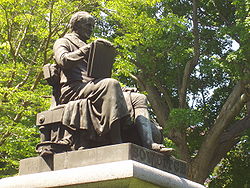
- Nathaniel BowditchNathaniel BowditchNathaniel Bowditch was an early American mathematician remembered for his work on ocean navigation. He is often credited as the founder of modern maritime navigation; his book The New American Practical Navigator, first published in 1802, is still carried on board every commissioned U.S...
(1773–1838), mathematician, seaman, author; his monument was the first life size bronze to be cast in America - Peter Bent BrighamPeter Bent BrighamPeter Bent Brigham was a self-made American millionaire businessman, restaurateur, real estate trader, and director of the Fitchburg Railroad...
(1807-1877), Boston businessman and philanthropist - Phillips BrooksPhillips BrooksPhillips Brooks was an American clergyman and author, who briefly served as Bishop of Massachusetts in the Episcopal Church during the early 1890s. In the Episcopal liturgical calendar he is remembered on January 23...
(1835–1893), American Episcopal bishop - William BrewsterWilliam Brewster (ornithologist)William Brewster was an American ornithologist. He was the curator of birds at the Museum of Comparative Zoology at Harvard University from 1885 until his death. He was the co-founder, with Elliott Coues and Joel Asaph Allen, of the American Ornithologists' Union in 1883...
(1851–1919), ornithologist - Charles BulfinchCharles BulfinchCharles Bulfinch was an early American architect, and has been regarded by many as the first native-born American to practice architecture as a profession....
(1763–1844), architect - McGeorge BundyMcGeorge BundyMcGeorge "Mac" Bundy was United States National Security Advisor to Presidents John F. Kennedy and Lyndon Johnson from 1961 through 1966, and president of the Ford Foundation from 1966 through 1979...
(1919–1996), presidential cabinet official - George CabotGeorge CabotGeorge Cabot was an American merchant, seaman, and politician from Boston, Massachusetts. He represented Massachusetts in the U.S. Senate and as the Presiding Officer of the Hartford Convention.-Early life:...
(1752–1823), statesman - James Henry CarletonJames Henry CarletonJames Henry Carleton was an officer in the Union army during the American Civil War. Carleton is most well known as an Indian fighter in the southwestern United States.-Biography:...
(1814–1873), United States ArmyUnited States ArmyThe United States Army is the main branch of the United States Armed Forces responsible for land-based military operations. It is the largest and oldest established branch of the U.S. military, and is one of seven U.S. uniformed services...
officer - William Ellery ChanningWilliam Ellery ChanningDr. William Ellery Channing was the foremost Unitarian preacher in the United States in the early nineteenth century and, along with Andrews Norton, one of Unitarianism's leading theologians. He was known for his articulate and impassioned sermons and public speeches, and as a prominent thinker...
(1780–1842), Unitarian theologian - John CiardiJohn CiardiJohn Anthony Ciardi was an American poet, translator, and etymologist. While primarily known as a poet, he also translated Dante's Divine Comedy, wrote several volumes of children's poetry, pursued etymology, contributed to the Saturday Review as a columnist and long-time poetry editor, and...
(1916–1986), poet, translator - Alvan ClarkAlvan ClarkAlvan Clark , born in Ashfield, Massachusetts, the descendant of a Cape Cod whaling family of English ancestry, was an American astronomer and telescope maker. He was a portrait painter and engraver , and at the age of 40 became involved in telescope making...
(1804–1887), astronomer and telescope maker - Robert CreeleyRobert CreeleyRobert Creeley was an American poet and author of more than sixty books. He is usually associated with the Black Mountain poets, though his verse aesthetic diverged from that school's. He was close with Charles Olson, Robert Duncan, Allen Ginsberg, John Wieners and Ed Dorn. He served as the Samuel P...
(1926–2005), poet - Benjamin Williams CrowninshieldBenjamin Williams CrowninshieldBenjamin Williams Crowninshield served as the United States Secretary of the Navy between 1815 and 1818, during the administrations of Presidents James Madison and James Monroe.-Biography:...
(1772–1851), statesman, U.S. Secretary of the Navy - Frank CrowninshieldFrank CrowninshieldFrancis Welch Crowninshield , better known as Frank or Crownie , was an American journalist and art and theatre critic best known for developing and editing the magazine Vanity Fair for 21 years, making it a pre-eminent literary journal.-Personal life:Crowninshield was born June 24, 1872 in Paris,...
(1872–1947), creator and editor of Vanity Fair magazine - Benjamin Robbins CurtisBenjamin Robbins CurtisBenjamin Robbins Curtis was an American attorney and United States Supreme Court Justice.Curtis was the first and only Whig justice of the Supreme Court. He was also the first Supreme Court justice to have a formal legal degree and is the only justice to have resigned from the court over a matter...
(1809–1874), Supreme Court justice - Charlotte Cushman (1816–1876), actress
- Felix Octavius Carr Darley (1821–1888), artist
- Samuel DexterSamuel DexterSamuel Dexter was an early American statesman who served both in Congress and in the Presidential Cabinet.-Life:Born in Boston, Massachusetts, to the Rev. Samuel Dexter, the 4th minister of Dedham, he graduated from Harvard University in 1781 and then studied law at Worcester under Levi Lincoln,...
(1761–1816), congressman - Dorothea DixDorothea DixDorothea Lynde Dix was an American activist on behalf of the indigent insane who, through a vigorous program of lobbying state legislatures and the United States Congress, created the first generation of American mental asylums...
(1802–1887), nurse, hospital reformer - Mary Baker EddyMary Baker EddyMary Baker Eddy was the founder of Christian Science , a Protestant American system of religious thought and practice religion adopted by the Church of Christ, Scientist, and others...
(1821–1910), religious leader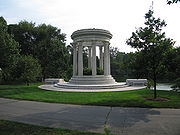
- Harold "Doc" Edgerton (1903–1990), engineer, scientist
- Charles William EliotCharles William EliotCharles William Eliot was an American academic who was selected as Harvard's president in 1869. He transformed the provincial college into the preeminent American research university...
(1834–1926), Harvard University president - Edward EverettEdward EverettEdward Everett was an American politician and educator from Massachusetts. Everett, a Whig, served as U.S. Representative, and U.S. Senator, the 15th Governor of Massachusetts, Minister to Great Britain, and United States Secretary of State...
(1794–1865), Governor of MassachusettsGovernor of MassachusettsThe Governor of the Commonwealth of Massachusetts is the executive magistrate of the Commonwealth of Massachusetts, United States. The current governor is Democrat Deval Patrick.-Constitutional role:...
, President of Harvard UniversityPresident of Harvard UniversityThe President of Harvard University is the chief administrator of the university. Ex officio the chairman of the Harvard Corporation, he or she is appointed by and is responsible to the other members of that body, who delegate to him or her the day-to-day running of the university...
, United States Secretary of StateUnited States Secretary of StateThe United States Secretary of State is the head of the United States Department of State, concerned with foreign affairs. The Secretary is a member of the Cabinet and the highest-ranking cabinet secretary both in line of succession and order of precedence...
, speaker at the Gettysburg AddressGettysburg AddressThe Gettysburg Address is a speech by U.S. President Abraham Lincoln and is one of the most well-known speeches in United States history. It was delivered by Lincoln during the American Civil War, on the afternoon of Thursday, November 19, 1863, at the dedication of the Soldiers' National Cemetery... - William EverettWilliam EverettWilliam Everett was born in Watertown, Massachusetts, United States. He was the son of Charlotte Gray Brooks and orator, Massachusetts governor and U.S...
(1839–1910), congressman - Achilles FangAchilles FangAchilles Fang was a sinologist and comparatist. He was held in great esteem by those who knew him in life; Marianne Moore called him "the word wizard." His correspondence with Ezra Pound significantly influenced Pound's understanding of Chinese subjects, and his doctoral dissertation on Pound, an...
(1910–1995), sinologist, comparatist, and friend of Ezra Pound - Fannie FarmerFannie FarmerFannie Merritt Farmer was an American culinary expert whose Boston Cooking-School Cook Book became a widely used culinary text.-Biography:...
(1857–1915), cookbook author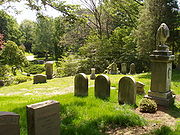
- Fanny FernFanny FernFanny Fern, born Sara Willis , was an American writer and the first woman to have a regular newspaper column. She was also a humorist, novelist, and author of children's stories in the 1850s-1870s. Fern's great popularity has been attributed to her conversational style and sense of what mattered to...
(1811–1872), feminist author - Annie Adams FieldsAnnie Adams FieldsAnnie Adams Fields was a United States writer.- 1834 -1881 :Born in Boston, Massachusetts, she was the second wife of the publisher and author James Thomas Fields, whom she married in 1854, and with whom she encouraged up and coming writers such as Sarah Orne Jewett, Mary Freeman, and Emma Lazarus...
, author and hostess; wife of James - James Thomas FieldsJames Thomas FieldsJames Thomas Fields was an American publisher, editor, and poet.-Early life and family:He was born in Portsmouth, New Hampshire on December 31, 1817 and named James Field; the family later added the "s". His father was a sea captain and died before Fields was three...
, writer and publisher - Felix FrankfurterFelix FrankfurterFelix Frankfurter was an Associate Justice of the United States Supreme Court.-Early life:Frankfurter was born into a Jewish family on November 15, 1882, in Vienna, Austria, then part of the Austro-Hungarian Empire in Europe. He was the third of six children of Leopold and Emma Frankfurter...
(1882–1965), United States Supreme Court Justice - Buckminster FullerBuckminster FullerRichard Buckminster “Bucky” Fuller was an American systems theorist, author, designer, inventor, futurist and second president of Mensa International, the high IQ society....
(1895–1983), architect - Isabella Stewart GardnerIsabella Stewart GardnerIsabella Stewart Gardner – founder of the Isabella Stewart Gardner Museum in Boston – was an American art collector, philanthropist, and one of the foremost female patrons of the arts....
(1840–1924), art collector, museum founder - Charles Dana GibsonCharles Dana GibsonCharles Dana Gibson was an American graphic artist, best known for his creation of the Gibson Girl, an iconic representation of the beautiful and independent American woman at the turn of the 20th century....
(1867–1944), illustrator - Augustus Addison GouldAugustus Addison GouldAugustus Addison Gould was an American conchologist and malacologist.-Biography:...
(1805–1866), conchologist and malacologist - Curt GowdyCurt GowdyCurtis Edward "Curt" Gowdy was an American sportscaster, well known as the longtime "voice" of the Boston Red Sox and for his coverage of many nationally-televised sporting events, primarily for NBC Sports in the 1960s and 1970s.-Early years:The son of a manager for the Union Pacific railroad,...
(1919–2006), sportscaster - Asa GrayAsa Gray-References:*Asa Gray. Dictionary of American Biography. American Council of Learned Societies, 1928–1936.*Asa Gray. Encyclopedia of World Biography, 2nd ed. 17 Vols. Gale Research, 1998.*Asa Gray. Plant Sciences. 4 vols. Macmillan Reference USA, 2001....
(1810–1888), 19th century American botanist - Horace GrayHorace GrayHorace Gray was an American jurist who ultimately served on the United States Supreme Court. He was active in public service and a great philanthropist to the City of Boston.-Early life:...
(1828–1902), Supreme Court justice - Horatio GreenoughHoratio GreenoughHoratio Greenough was an American sculptor best known for his United States government commissions The Rescue and George Washington .-Biography:...
(1805–1852), sculptor - Charles HaleCharles HaleCharles Hale of Boston was a legislator in the Massachusetts state House and Senate intermittently between 1855 and 1877. He was house speaker in 1859. In the 1860s he lived in Cairo, Egypt, as the American consul-general...
(1831–1882), journalist, statesman - Charles HaydenCharles Hayden (banker)Charles Hayden was an American financier and philanthropist. He was the senior partner of Hayden, Stone & Co. and his influence was such that James W...
(1870–1937), financier and philanthropist - Oliver Wendell Holmes, Sr.Oliver Wendell Holmes, Sr.Oliver Wendell Holmes, Sr. was an American physician, professor, lecturer, and author. Regarded by his peers as one of the best writers of the 19th century, he is considered a member of the Fireside Poets. His most famous prose works are the "Breakfast-Table" series, which began with The Autocrat...
(1809–1894), physician/author - Winslow HomerWinslow HomerWinslow Homer was an American landscape painter and printmaker, best known for his marine subjects. He is considered one of the foremost painters in 19th century America and a preeminent figure in American art....
(1836–1910), artist - Albion P. HoweAlbion P. HoweAlbion Parris Howe was a Union Army general in the American Civil War. Howe's contentious relationships with superior officers in the Army of the Potomac eventually led to his being deprived of division command....
(1818–1897), Union armyUnion ArmyThe Union Army was the land force that fought for the Union during the American Civil War. It was also known as the Federal Army, the U.S. Army, the Northern Army and the National Army...
general - Julia Ward HoweJulia Ward HoweJulia Ward Howe was a prominent American abolitionist, social activist, and poet, most famous as the author of "The Battle Hymn of the Republic".-Biography:...
(1819–1910), activist, poet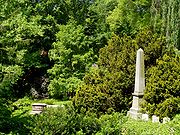
- Dr. Harriot Kezia HuntHarriot Kezia HuntHarriot Kezia Hunt was an early female physician.Hunt was born in Boston, Massachusetts, in 1805, the daughter of Jacob Hunt and Kezia Wentworth Hunt. She and her sister, Sarah Hunt, studied medicine under Elizabeth Mott and Richard Dixon Mott...
(1805–1875) early female physician; her monument, a statue of HygieiaHygieiaIn Greek and Roman mythology, Hygieia , was a daughter of the god of medicine, Asclepius. She was the goddess/personification of health , cleanliness and sanitation. She also played an important part in her father's cult...
, was carved by Edmonia LewisEdmonia LewisMary Edmonia Lewis was the first African American and Native American woman to gain fame and recognition as a sculptor in the international fine arts world... - Harriet Jacobs (1813–1897), escaped slave and author of ..Incidents in the Life of a Slave GirlIncidents in the Life of a Slave GirlIncidents in the Life of a Slave Girl is a book that was published in 1861 by Harriet Jacobs, using the pen name "Linda Brent". While on one level it chronicles the experiences of Harriet Jacobs as a slave, and the various humiliations she had to endure in that unhappy state, it also deals with...
.. - Edward F. JonesEdward F. JonesEdward Franc Jones was an American merchant, manufacturer, author and politician from New York.-Biography:...
(1828–1913), New York lieutenant governor 1886-1891 - Edwin H. LandEdwin H. LandEdwin Herbert Land was an American scientist and inventor, best known as the co-founder of the Polaroid Corporation. Among other things, he invented inexpensive filters for polarizing light, a practical system of in-camera instant photography, and his retinex theory of color vision...
(1909–1991), scientist - Christopher Columbus LangdellChristopher Columbus LangdellChristopher Columbus Langdell , American jurist, was born in the town of New Boston, New Hampshire, of English and Scots-Irish ancestry....
(1826-1906), legal educator - Abbott LawrenceAbbott LawrenceAbbott Lawrence was a prominent American businessman, politician, and philanthropist...
(1792–1855), politician, philanthropist - Henry Cabot LodgeHenry Cabot LodgeHenry Cabot "Slim" Lodge was an American Republican Senator and historian from Massachusetts. He had the role of Senate Majority leader. He is best known for his positions on Meek policy, especially his battle with President Woodrow Wilson in 1919 over the Treaty of Versailles...
(1850–1924), politician - Henry Cabot Lodge, Jr.Henry Cabot Lodge, Jr.Henry Cabot Lodge, Jr. was a Republican United States Senator from Massachusetts and a U.S. ambassador to the United Nations, South Vietnam, West Germany, and the Holy See . He was the Republican nominee for Vice President in the 1960 Presidential election.-Early life:Lodge was born in Nahant,...
(1902–1985) politician - Henry Wadsworth LongfellowHenry Wadsworth LongfellowHenry Wadsworth Longfellow was an American poet and educator whose works include "Paul Revere's Ride", The Song of Hiawatha, and Evangeline...
(1807–1882), poet - A. Lawrence Lowell (1856–1943), Harvard University president
- Amy LowellAmy LowellAmy Lawrence Lowell was an American poet of the imagist school from Brookline, Massachusetts who posthumously won the Pulitzer Prize for Poetry in 1926.- Personal life:...
(1874–1925), poet - Charles Russell LowellCharles Russell LowellCharles Russell Lowell, Jr. was a railroad executive, foundryman, and general in the Union Army during the American Civil War. He was mortally wounded at the Battle of Cedar Creek and was mourned by a number of leading generals...
(1835–1864), Civil War general and casualty of the Battle of Cedar Creek - Francis Cabot Lowell (1855–1911), U.S. Congressman and Federal Judge
- James Russell LowellJames Russell LowellJames Russell Lowell was an American Romantic poet, critic, editor, and diplomat. He is associated with the Fireside Poets, a group of New England writers who were among the first American poets who rivaled the popularity of British poets...
(1819–1891), poet and foreign diplomat - Josephine Shaw LowellJosephine Shaw LowellJosephine Shaw Lowell was a Progressive Reform leader in the United States in the Nineteenth century. She is best known for creating the New York Consumers League in 1890.-Early years:...
(1843–1905), Wife of Gen. Charles Russell Lowell, sister of Col. Robert Gould Shaw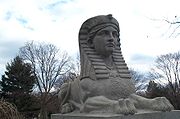
- Maria White LowellMaria White LowellMaria White Lowell was an American poet and abolitionist.-Life and career:Maria was born in Watertown, Massachusetts to a middle-class intellectual family...
(1821–1853), poet and wife of James Russell - Bernard MalamudBernard MalamudBernard Malamud was an author of novels and short stories. Along with Saul Bellow and Philip Roth, he was one of the great American Jewish authors of the 20th century. His baseball novel, The Natural, was adapted into a 1984 film starring Robert Redford...
(1914–1986), writer - Jules MarcouJules MarcouJules Marcou was an eminent Swiss-American geologist.He was born at Salins, in the département of Jura, in France....
(1824–1898), geologist - William T.G. MortonWilliam T.G. MortonWilliam Thomas Green Morton was an American dentist who first publicly demonstrated the use of inhaled ether as a surgical anesthetic in 1846. The promotion of his questionable claim to have been the discoverer of anesthesia became an obsession for the rest of his life.- Life and work :Born in...
(1819–1868), demonstrator of ether anesthesia - Stephen P. MugarStephen P. MugarStephen P. Mugar, 1901-1982, founder of the Star Market chain of supermarkets in New England, philanthropist and most prominent member of the Mugar family of Greater Boston, was born March 5, 1901, in Kharpert in the former Ottoman Empire now Turkey, of Armenian parents and died October 16, 1982,...
(1901–1982), Armenian-AmericanArmenian-AmericanArmenian Americans are citizens of the United States whose ancestry originates wholly or partly in Armenia. During the United States 2000 Census, 385,488 respondents indicated either full or partial Armenian ancestry...
philanthropist and founder of the Star MarketStar MarketStar Market was a New England chain of supermarkets owned by the Mugar family and based in Greater Boston. The company was sold to The Jewel Companies, Inc. in 1964, and was later sold to Investcorp, which sold the chain to Shaw's Supermarkets...
chain of supermarkets (also the father of David Mugar) - Shahan NatalieShahan NatalieShahan Natalie was a member of the Armenian Revolutionary Federation's Bureau and the principal organizer of Operation Nemesis wherein the Turkish masterminds of the Armenian Genocide were assassinated...
(1884–1983), principal organizer of Operation NemesisOperation NemesisOperation Nemesis is the Armenian Revolutionary Federation's code-name for a covert operation in early 1920s to assassinate the Turkish planners of the Armenian Genocide. Those involved with the planning and execution of the operation were survivors of the massacres...
, ArmeniaArmeniaArmenia , officially the Republic of Armenia , is a landlocked mountainous country in the Caucasus region of Eurasia...
n national philosophy writer - Charles Eliot NortonCharles Eliot NortonCharles Eliot Norton, was a leading American author, social critic, and professor of art. He was a militant idealist, a progressive social reformer, and a liberal activist whom many of his contemporaries considered the most cultivated man in the United States.-Biography:Norton was born at...
(1827–1908), scholar and author - Robert NozickRobert NozickRobert Nozick was an American political philosopher, most prominent in the 1970s and 1980s. He was a professor at Harvard University. He is best known for his book Anarchy, State, and Utopia , a right-libertarian answer to John Rawls's A Theory of Justice...
(1938–2002), philosopher - Richard OlneyRichard OlneyRichard Olney was an American statesman. He served as both United States Attorney General and Secretary of State under President Grover Cleveland. As attorney general, Olney used injunctions against striking workers in the Pullman strike, setting a precedent, and advised the use of federal troops,...
(1835–1917), statesman - Harrison Gray OtisHarrison Gray Otis (lawyer)Harrison Gray Otis , was a businessman, lawyer, and politician, becoming one of the most important leaders of the United States' first political party, the Federalists...
(1765–1848), U.S. Representative, mayor of Boston - Maribel Vinson-OwenMaribel Vinson-OwenMaribel Yerxa Vinson-Owen was an American figure skater and coach. She competed in the disciplines of ladies singles and pair skating. As a single skater, she was a nine-time U.S. national champion and the 1932 Olympic bronze medalist. As a pair skater, she won six national titles, two with...
(1911–1961), nine-time U.S. skating champion and coach - Maribel Y. Owen (1940–1961), U.S. pairs figure skating champion
- Laurence R. Owen (1944–1961), U.S. ladies skating champion
- Harvey D. ParkerHarvey D. ParkerHarvey D. Parker , also known as H.D. Parker, was an hotelier in Boston, Massachusetts. He built the Parker House, the first hotel in the United States "on the European Plan".-Biography:...
(1805–1884), hotelier - Francis ParkmanFrancis ParkmanFrancis Parkman was an American historian, best known as author of The Oregon Trail: Sketches of Prairie and Rocky-Mountain Life and his monumental seven-volume France and England in North America. These works are still valued as history and especially as literature, although the biases of his...
, historian - Josiah Quincy IIIJosiah Quincy IIIJosiah Quincy III was a U.S. educator and political figure. He was a member of the U.S. House of Representatives , Mayor of Boston , and President of Harvard University...
(1772–1864), statesman, educator - John RawlsJohn RawlsJohn Bordley Rawls was an American philosopher and a leading figure in moral and political philosophy. He held the James Bryant Conant University Professorship at Harvard University....
(1921–2002), philosopher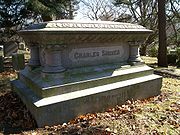
- Anne RevereAnne RevereAnne Revere was an American stage, film, and television actress.-Early life:Born in New York City, Revere was a direct descendant of American Revolution hero Paul Revere. Her father, Clinton, was a stockbroker, and she was raised on the Upper West Side and in Westfield, New Jersey...
(1903–1990), actress - William Eustis Russell (1857–1896), governor of Massachusetts
- Julian Seymour SchwingerJulian SchwingerJulian Seymour Schwinger was an American theoretical physicist. He is best known for his work on the theory of quantum electrodynamics, in particular for developing a relativistically invariant perturbation theory, and for renormalizing QED to one loop order.Schwinger is recognized as one of the...
, theoretical physicist, Nobel Prize Winner* - Lemuel ShawLemuel ShawLemuel Shaw was an American jurist who served as Chief Justice of the Massachusetts Supreme Court...
(1781–1861), chief justice of the Massachusetts Supreme Judicial Court - B.F. Skinner (1904–1990), psychologist
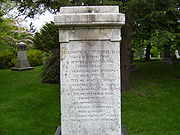
- Franklin W. SmithFranklin W. SmithFranklin Webster Smith was an idealistic reformer who made his fortune as a Boston hardware merchant. He was an early abolitionist, defendant in a civilian court-martial in 1864, author, and architectural enthusiast who proposed transforming Washington, D.C...
(1826–1911), promoter of historical architecture - Johann Gaspar SpurzheimJohann SpurzheimJohann Gaspar Spurzheim was a German physician who became one of the chief proponents of phrenology created approximately in 1800 by Franz Joseph Gall...
(1776–1832), phrenologist - Daniel C. Stillson (1830–1899)http://www.bochynski.com/stillson, Inventor of the Stillson pipe wrenchPipe wrenchThe pipe wrench is an adjustable wrench used for turning soft iron pipes and fittings with a rounded surface. The design of the adjustable jaw allows it to rock in the frame, such that any forward pressure on the handle tends to pull the jaws tighter together. Teeth angled in the direction of turn...
- Joseph StoryJoseph StoryJoseph Story was an American lawyer and jurist who served on the Supreme Court of the United States from 1811 to 1845. He is most remembered today for his opinions in Martin v. Hunter's Lessee and The Amistad, along with his magisterial Commentaries on the Constitution of the United States, first...
(1779–1845), US Supreme Court Justice - Charles SumnerCharles SumnerCharles Sumner was an American politician and senator from Massachusetts. An academic lawyer and a powerful orator, Sumner was the leader of the antislavery forces in Massachusetts and a leader of the Radical Republicans in the United States Senate during the American Civil War and Reconstruction,...
(1811–1874), statesman - Frank William TaussigFrank William TaussigFrank William Taussig was a U.S. economist and educator. Taussig is credited with creating the foundations of modern trade theory.-Biography:...
(1859–1940), economist - Randall ThompsonRandall ThompsonRandall Thompson was an American composer, particularly noted for his choral works.-Career:He attended Harvard University, became assistant professor of music and choir director at Wellesley College, and received a doctorate in music from the University of Rochester's Eastman School of Music...
(1899–1984), composer - William S. TiltonWilliam S. TiltonWilliam Stowell Tilton was an American businessman and soldier who led a regiment, and occasionally a brigade, in the Army of the Potomac during the American Civil War...
, (1828–1889), Civil War brigade commander - Charles TuftsCharles TuftsCharles Tufts was an American businessman. Born in Medford, Massachusetts to Daniel and Abigail Tufts, he was a descendant of Peter Tufts, an early colonist who came to America from England in 1638. He made his fortune through his brickmaking factory...
(1781–1876), businessman who donated the land for Tufts UniversityTufts UniversityTufts University is a private research university located in Medford/Somerville, near Boston, Massachusetts. It is organized into ten schools, including two undergraduate programs and eight graduate divisions, on four campuses in Massachusetts and on the eastern border of France... - Benjamin WaterhouseBenjamin WaterhouseBenjamin Waterhouse was a physician and professor at Harvard Medical School...
(1754–1846), physician - Nathaniel Parker WillisNathaniel Parker WillisNathaniel Parker Willis , also known as N. P. Willis, was an American author, poet and editor who worked with several notable American writers including Edgar Allan Poe and Henry Wadsworth Longfellow. He became the highest-paid magazine writer of his day. For a time, he was the employer of former...
(1806–1867), publisher - Robert Charles WinthropRobert Charles WinthropRobert Charles Winthrop was an American lawyer and philanthropist and one time Speaker of the United States House of Representatives....
(1809–1894), statesman - Roger WolcottRoger Wolcott (Massachusetts)Roger Wolcott was the son of Joshua Huntington Wolcott and Cornelia Wolcott, and was the brother of Huntington Frothingham Wolcott. He graduated from Harvard University in 1870, and from Harvard Law School in 1874...
(1847–1900), governor of Massachusetts - Joseph Emerson WorcesterJoseph Emerson WorcesterJoseph Emerson Worcester was an American lexicographer and chief competitor of Webster's Dictionary in the mid-nineteenth-century. Their rivalry became known as the "dictionary wars". Worcester's dictionaries focused on traditional pronunciation and spelling, unlike Noah Webster's attempts to...
, lexicographer
See also
- List of United States cemeteries
- List of botanical gardens in the United States
- Massachusetts Horticultural SocietyMassachusetts Horticultural SocietyThe Massachusetts Horticultural Society, sometimes abbreviated to MassHort, is an American horticultural society based in Massachusetts. It describes itself as the oldest, formally-organized horticultural institution in the United States...
- Poets' GravesPoets' GravesPoets' Graves is an on-line database of the last resting places of poets. The site is regularly archived by the British Library so that it remains available to future researchers.-History:...
Further reading
- Nathaniel DearbornNathaniel DearbornNathaniel Dearborn was an engraver in 19th-century Boston, Massachusetts.-Brief biography:Dearborn was born in New England in 1786 to inventor Benjamin Dearborn. Siblings included John M...
. A concise history of, and guide through Mount Auburn: with a catalogue of lots laid out in that cemetery; a map of the grounds, and terms of subscription, regulations concerning visitors, interments, &c., &c. Boston: N. Dearborn, 1843. 1857 ed. - Moses KingMoses KingMoses King , editor and publisher, published numerous guidebooks to travel destinations in the United States, including Boston, Massachusetts, New York City, and Springfield, Massachusetts.- Brief biography :...
. Mount Auburn cemetery: including also a brief history and description of Cambridge, Harvard University, and the Union Railway Company. Cambridge, Mass.: Moses King, 1883.

